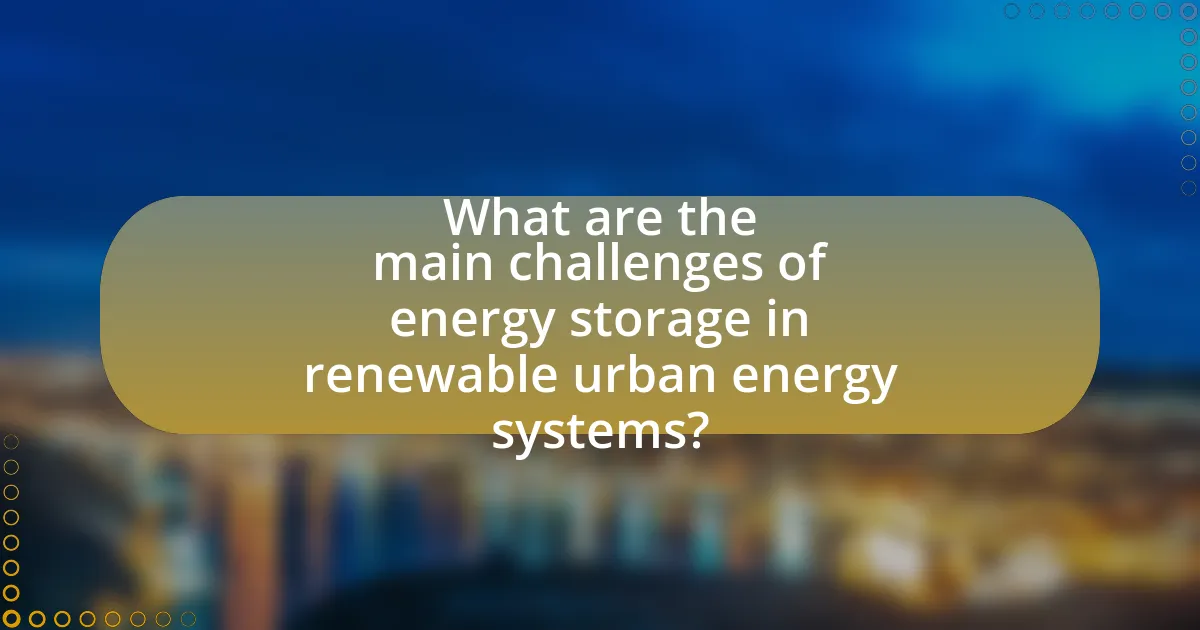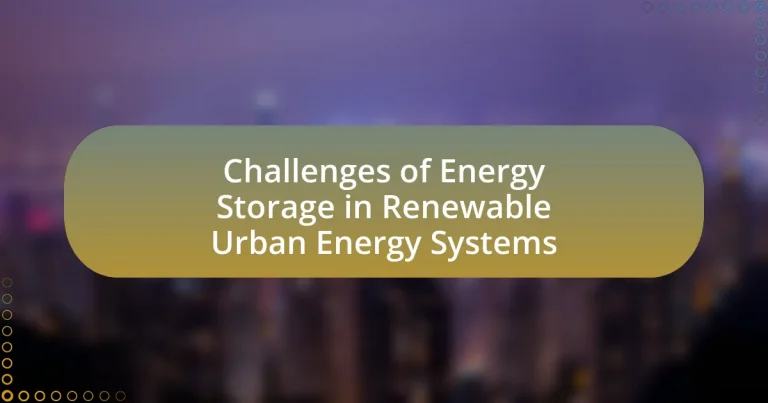The article focuses on the challenges of energy storage in renewable urban energy systems, highlighting key issues such as high costs, limited storage capacity, and integration with existing infrastructure. It examines the impact of technological limitations on energy storage solutions, comparing current technologies like lithium-ion batteries, pumped hydro storage, and emerging alternatives. The role of policy and regulations in shaping energy storage implementation is discussed, along with financial barriers and the economic implications of storage challenges. Additionally, the article explores innovative solutions and collaborative efforts aimed at improving energy storage efficiency and effectiveness in urban environments.

What are the main challenges of energy storage in renewable urban energy systems?
The main challenges of energy storage in renewable urban energy systems include high costs, limited storage capacity, and integration with existing infrastructure. High costs are a significant barrier, as advanced storage technologies like lithium-ion batteries can be expensive to implement and maintain, impacting overall project feasibility. Limited storage capacity restricts the ability to store excess energy generated during peak production times, leading to potential energy waste. Additionally, integrating energy storage solutions with existing urban infrastructure poses technical challenges, as compatibility and efficiency must be ensured to optimize energy flow and usage. These challenges hinder the widespread adoption and effectiveness of renewable energy systems in urban environments.
How do technological limitations impact energy storage solutions?
Technological limitations significantly hinder the efficiency and scalability of energy storage solutions. These limitations include issues such as energy density, charge/discharge rates, and cycle life, which directly affect the performance and longevity of storage systems. For instance, lithium-ion batteries, widely used for energy storage, have a limited energy density of about 250 Wh/kg, which restricts the amount of energy they can store relative to their weight. Additionally, the charge/discharge rates can lead to thermal management challenges, impacting safety and efficiency. Research indicates that advancements in materials science, such as the development of solid-state batteries, could potentially overcome some of these limitations, but widespread adoption remains a challenge due to high production costs and manufacturing complexities.
What specific technologies are currently used for energy storage?
Current technologies used for energy storage include lithium-ion batteries, pumped hydro storage, flywheel energy storage, and solid-state batteries. Lithium-ion batteries dominate the market due to their high energy density and efficiency, accounting for over 90% of the global battery storage capacity as of 2023. Pumped hydro storage, which utilizes gravitational potential energy, represents about 95% of the world’s large-scale energy storage capacity, making it a reliable option for balancing supply and demand. Flywheel energy storage systems provide rapid response times and are suitable for short-duration applications, while solid-state batteries are emerging as a safer alternative with higher energy densities and longer lifespans. These technologies collectively address the challenges of energy storage in renewable urban energy systems by enhancing grid stability and enabling the integration of intermittent renewable sources.
How do these technologies compare in terms of efficiency and cost?
The comparison of energy storage technologies in renewable urban energy systems reveals that lithium-ion batteries are generally more efficient and cost-effective than alternatives like lead-acid batteries and pumped hydro storage. Lithium-ion batteries typically achieve round-trip efficiencies of around 90-95%, while lead-acid batteries range from 70-80%, and pumped hydro can vary widely based on site conditions but often falls between 70-90%. In terms of cost, lithium-ion batteries have seen a significant reduction in price, dropping from over $1,000 per kWh in 2010 to approximately $150 per kWh in 2020, making them a more economically viable option for urban energy systems. In contrast, lead-acid batteries remain cheaper upfront but have shorter lifespans and lower efficiency, leading to higher overall costs over time. Pumped hydro, while efficient, requires significant capital investment and is limited by geographical constraints, making it less favorable for urban applications.
What role does policy play in the challenges of energy storage?
Policy plays a crucial role in shaping the challenges of energy storage by influencing regulations, funding, and market structures. Effective policies can promote research and development, incentivize investments in energy storage technologies, and establish standards that facilitate integration with renewable energy sources. For instance, the U.S. Energy Storage Association highlights that supportive policies, such as tax credits and grants, have led to significant growth in energy storage capacity, which reached over 3.5 gigawatts in 2020. Conversely, inadequate or unclear policies can hinder investment and slow down the deployment of energy storage solutions, creating barriers to achieving energy transition goals.
How do regulations affect the implementation of energy storage systems?
Regulations significantly influence the implementation of energy storage systems by establishing standards, incentives, and barriers that shape market dynamics. For instance, regulatory frameworks can dictate the technical specifications required for energy storage technologies, impacting their design and operational capabilities. Additionally, policies such as tax credits or subsidies can incentivize investment in energy storage, while stringent interconnection rules may delay deployment. According to the U.S. Department of Energy, states with supportive regulatory environments have seen a 50% increase in energy storage installations compared to those with restrictive policies. Thus, the regulatory landscape directly affects the pace and scale of energy storage system adoption.
What incentives exist for improving energy storage in urban areas?
Incentives for improving energy storage in urban areas include financial subsidies, tax credits, and regulatory support aimed at enhancing renewable energy integration. For instance, the U.S. federal government offers the Investment Tax Credit (ITC), which allows for a 26% tax credit on solar energy systems, including energy storage components. Additionally, many states provide grants and rebates for energy storage projects, encouraging local governments and businesses to invest in these technologies. These financial incentives are designed to reduce the upfront costs associated with energy storage systems, making them more accessible and attractive for urban applications. Furthermore, regulatory frameworks, such as California’s Self-Generation Incentive Program (SGIP), promote energy storage by providing incentives for residential and commercial installations, thereby facilitating the transition to more sustainable urban energy systems.
How does the integration of renewable energy sources complicate storage solutions?
The integration of renewable energy sources complicates storage solutions due to their intermittent and variable nature. Renewable energy sources, such as solar and wind, produce energy that is not consistently available, leading to mismatches between energy supply and demand. For instance, solar energy generation peaks during the day while energy consumption often peaks in the evening, creating a need for effective storage solutions to bridge this gap. Additionally, the fluctuating output from wind energy can lead to periods of excess generation followed by shortfalls, further complicating the management of energy storage systems. These challenges necessitate advanced storage technologies, such as batteries or pumped hydro storage, which must be capable of responding quickly to changes in energy availability and demand, thereby increasing the complexity and cost of energy storage solutions.
What are the specific challenges posed by solar and wind energy integration?
The specific challenges posed by solar and wind energy integration include variability in energy generation, grid stability issues, and the need for advanced energy storage solutions. Variability arises because solar and wind resources are dependent on weather conditions, leading to fluctuations in energy output that can disrupt supply consistency. Grid stability issues occur as the intermittent nature of these energy sources can cause frequency and voltage fluctuations, complicating the management of the electrical grid. Additionally, effective integration requires advanced energy storage systems to store excess energy generated during peak production times for use during low production periods, which presents technological and economic challenges. For instance, the International Renewable Energy Agency (IRENA) reports that energy storage technologies must be developed and deployed at scale to support the transition to a renewable energy grid.
How do fluctuations in energy supply affect storage needs?
Fluctuations in energy supply significantly increase storage needs to ensure a stable energy supply. When renewable energy sources, such as solar and wind, experience variability due to weather conditions, the demand for energy storage systems rises to balance supply and demand. For instance, during periods of high energy generation, excess energy can be stored for later use, while during low generation periods, stored energy can be released to meet consumption needs. According to the International Renewable Energy Agency, energy storage capacity must expand to accommodate the projected increase in renewable energy generation, which is expected to reach 80% of global electricity by 2050. This necessitates advancements in storage technologies and infrastructure to effectively manage the intermittent nature of renewable energy sources.

What are the economic implications of energy storage challenges?
Energy storage challenges have significant economic implications, primarily affecting energy prices, investment in renewable technologies, and grid reliability. High costs associated with developing and deploying effective energy storage solutions can lead to increased electricity prices for consumers, as utilities may pass on these expenses. For instance, the International Renewable Energy Agency reported that energy storage systems can account for up to 30% of the total cost of renewable energy projects. Additionally, inadequate storage capacity can deter investment in renewable energy infrastructure, as investors seek stable returns, which are jeopardized by unreliable energy supply. Furthermore, energy storage challenges can compromise grid reliability, leading to increased operational costs for utilities that must manage supply and demand fluctuations without adequate storage solutions. This situation can result in economic inefficiencies and hinder the transition to a sustainable energy future.
How do energy storage costs influence urban energy systems?
Energy storage costs significantly influence urban energy systems by determining the feasibility and scalability of integrating renewable energy sources. High energy storage costs can limit the adoption of technologies such as batteries, which are essential for balancing supply and demand, especially in cities with variable renewable energy generation. For instance, the cost of lithium-ion batteries has decreased from over $1,000 per kilowatt-hour in 2010 to around $150 per kilowatt-hour in 2020, making energy storage more accessible and enabling cities to implement more sustainable energy solutions. Conversely, if storage costs remain high, urban planners may rely more on traditional fossil fuel sources, hindering efforts to reduce greenhouse gas emissions and achieve energy resilience.
What are the financial barriers to adopting energy storage technologies?
The financial barriers to adopting energy storage technologies include high initial capital costs, limited access to financing, and uncertain return on investment. High initial capital costs can deter investment, as energy storage systems often require significant upfront expenditures; for instance, lithium-ion battery systems can cost between $400 to $700 per kilowatt-hour. Limited access to financing arises from the perceived risks associated with new technologies, making it difficult for developers to secure loans or attract investors. Additionally, uncertain return on investment is a critical barrier, as fluctuating energy prices and regulatory changes can impact the profitability of energy storage projects, leading to hesitance among potential adopters.
How can economies of scale reduce energy storage costs?
Economies of scale can reduce energy storage costs by lowering the per-unit cost of production as the scale of operation increases. When energy storage systems, such as batteries, are produced in larger quantities, manufacturers benefit from bulk purchasing of materials, streamlined production processes, and reduced labor costs. For instance, a study by the International Renewable Energy Agency (IRENA) found that the cost of lithium-ion batteries fell by 89% between 2010 and 2019, largely due to increased production capacity and technological advancements driven by higher demand. This demonstrates that as production scales up, the fixed costs are spread over a larger number of units, resulting in lower costs per unit and making energy storage more economically viable for renewable urban energy systems.
What impact do energy storage challenges have on energy prices?
Energy storage challenges significantly increase energy prices by limiting the ability to store excess renewable energy for later use. When energy storage systems are inadequate or inefficient, it leads to a mismatch between energy supply and demand, particularly during peak usage times. For instance, according to the International Renewable Energy Agency, the lack of effective energy storage can result in a 30% increase in electricity prices during high demand periods, as utilities must rely on more expensive fossil fuel sources to meet demand. This reliance on costly alternatives drives up overall energy costs for consumers and businesses alike.
How do storage solutions affect the overall cost of renewable energy?
Storage solutions significantly impact the overall cost of renewable energy by enabling the efficient management of energy supply and demand. These solutions, such as batteries and pumped hydro storage, allow for energy generated during peak production times to be stored and used during periods of high demand or low generation, thus enhancing the reliability and economic viability of renewable sources. According to a report by the International Renewable Energy Agency (IRENA), the cost of battery storage has decreased by 89% from 2010 to 2019, which directly contributes to lowering the levelized cost of electricity (LCOE) for renewables. This reduction in storage costs makes renewable energy more competitive with fossil fuels, ultimately driving down the overall cost of renewable energy systems.
What are the long-term economic benefits of overcoming storage challenges?
Overcoming storage challenges in renewable urban energy systems leads to significant long-term economic benefits, including reduced energy costs and enhanced energy efficiency. By improving storage solutions, cities can better manage energy supply and demand, which lowers reliance on expensive peak power sources. For instance, a study by the International Renewable Energy Agency (IRENA) indicates that energy storage can reduce electricity costs by up to 30% in certain scenarios. Additionally, effective storage systems enable the integration of more renewable energy sources, which can lead to job creation in the green technology sector and stimulate local economies. Furthermore, enhanced storage capabilities can increase grid reliability, reducing the economic impact of outages and improving overall productivity.

What innovative solutions are being explored to address energy storage challenges?
Innovative solutions being explored to address energy storage challenges include advanced battery technologies, such as solid-state batteries and flow batteries, which offer higher energy densities and longer lifespans compared to traditional lithium-ion batteries. Research indicates that solid-state batteries can potentially increase energy density by 50% and improve safety by eliminating flammable liquid electrolytes. Additionally, the integration of artificial intelligence in energy management systems optimizes storage and distribution, enhancing efficiency. For instance, AI algorithms can predict energy demand and adjust storage operations accordingly, leading to more effective use of renewable energy sources. These advancements are crucial for overcoming the limitations of current energy storage systems in urban environments.
How are advancements in technology shaping the future of energy storage?
Advancements in technology are significantly shaping the future of energy storage by enhancing efficiency, capacity, and sustainability. Innovations such as solid-state batteries, which offer higher energy densities and improved safety compared to traditional lithium-ion batteries, are paving the way for more effective energy storage solutions. For instance, a study published in the journal Nature Energy in 2020 highlighted that solid-state batteries could potentially increase energy storage capacity by up to 50% while reducing fire risks. Additionally, developments in flow battery technology are enabling longer-duration energy storage, which is crucial for balancing intermittent renewable energy sources like solar and wind. According to a report by the International Renewable Energy Agency (IRENA), advancements in energy storage technologies could reduce costs by up to 70% by 2030, making renewable energy systems more viable in urban settings. These technological improvements are essential for addressing the challenges of energy storage in renewable urban energy systems, facilitating a transition to cleaner energy sources.
What emerging technologies show promise for improving energy storage?
Emerging technologies that show promise for improving energy storage include solid-state batteries, flow batteries, and advanced supercapacitors. Solid-state batteries utilize a solid electrolyte instead of a liquid one, enhancing energy density and safety, as evidenced by research from Toyota and other manufacturers indicating a potential increase in energy capacity by 50% compared to traditional lithium-ion batteries. Flow batteries, such as vanadium redox flow batteries, offer scalability and long cycle life, with studies showing they can provide energy storage for renewable sources like solar and wind for extended periods. Advanced supercapacitors, which can charge and discharge rapidly, are being developed to complement batteries in applications requiring quick bursts of energy, with research from the University of California demonstrating their effectiveness in grid stabilization.
How can smart grid technology enhance energy storage efficiency?
Smart grid technology enhances energy storage efficiency by optimizing the management and distribution of energy resources. It utilizes real-time data analytics and advanced communication systems to balance supply and demand, allowing for better integration of renewable energy sources. For instance, smart grids can predict energy consumption patterns and adjust storage operations accordingly, reducing energy waste and improving the overall efficiency of storage systems. According to a study by the U.S. Department of Energy, implementing smart grid technologies can increase energy storage utilization by up to 30%, demonstrating their significant impact on efficiency in renewable urban energy systems.
What collaborative efforts are being made to tackle energy storage issues?
Collaborative efforts to tackle energy storage issues include partnerships between governments, research institutions, and private companies focused on developing advanced battery technologies and energy management systems. For instance, the U.S. Department of Energy’s Energy Storage Grand Challenge aims to accelerate the development of next-generation energy storage solutions through public-private collaborations, targeting a 90% reduction in the cost of grid-scale energy storage by 2030. Additionally, initiatives like the Global Energy Storage Alliance bring together stakeholders from various sectors to share knowledge and best practices, enhancing the overall effectiveness of energy storage solutions in urban renewable energy systems.
How are public-private partnerships contributing to energy storage innovation?
Public-private partnerships are significantly contributing to energy storage innovation by facilitating funding, research collaboration, and technology development. These partnerships leverage the strengths of both sectors; public entities provide regulatory support and funding, while private companies bring expertise and efficiency in technology deployment. For instance, the U.S. Department of Energy has engaged in partnerships with companies like Tesla and Fluence to advance battery storage technologies, resulting in projects that enhance grid reliability and integrate renewable energy sources. This collaborative approach has led to the development of advanced energy storage solutions, such as lithium-ion batteries and flow batteries, which are crucial for managing the intermittent nature of renewable energy sources like solar and wind.
What role do research institutions play in developing new storage solutions?
Research institutions play a critical role in developing new storage solutions by conducting innovative research and facilitating technological advancements. They focus on exploring novel materials and methods for energy storage, such as advanced battery technologies and supercapacitors, which are essential for enhancing the efficiency and sustainability of renewable energy systems. For instance, studies from institutions like the Massachusetts Institute of Technology have led to breakthroughs in lithium-sulfur batteries, which offer higher energy densities compared to traditional lithium-ion batteries. Additionally, research institutions often collaborate with industry partners to translate theoretical findings into practical applications, thereby accelerating the deployment of effective storage solutions in urban energy systems.
What best practices can urban planners adopt to improve energy storage systems?
Urban planners can improve energy storage systems by integrating energy storage solutions into urban infrastructure planning. This includes designing multi-use facilities that incorporate energy storage alongside other urban functions, such as transportation and housing, to optimize space and resources. Additionally, planners should prioritize the use of renewable energy sources to charge storage systems, enhancing sustainability and reducing reliance on fossil fuels.
Implementing smart grid technologies is another best practice, as it allows for real-time monitoring and management of energy flows, improving the efficiency of energy storage systems. Furthermore, urban planners should engage with local communities to identify specific energy needs and preferences, ensuring that storage solutions are tailored to the unique characteristics of each urban area.
Evidence supporting these practices includes studies showing that cities implementing integrated energy storage solutions have seen reductions in energy costs and increased resilience against power outages. For instance, a report by the International Renewable Energy Agency highlights that cities with smart grid technologies can reduce energy waste by up to 30%.


